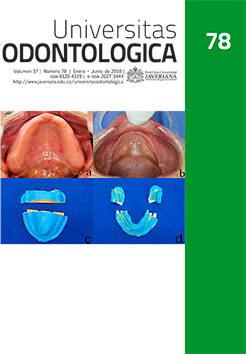Abstract
Background: The pursuit of esthetic excellence has become a major goal in the dental treatment. Gummy smile is one of the complaints of the patients, since such a situation can influence self-esteem and social relationships. The beauty of the smile is not only constituted by the shape, position and size of the teeth, but also based on the characteristics of the gingival tissue and conformation of the lips, which should be as harmonious as teeth. The development of new more conservative techniques may provide a better therapeutic option than surgical procedures, such as the application of botulinum toxin, in the treatment of gummy smile. Purpose: to present the case of a patient who presented dentogingival discrepancy caused by gingival overgrowth and gummy smile, treated by gingivoplasty and complemented by application of botulinum toxin. Description of the case: The gingivoplasty was performed followed by the application of botulinum toxin type A. Results: The gingivoplasty resulted of the improvement of gingival arches and the application of botulinum toxin promoted the dehiscence of upper lip, reducing the gingival exposure. Conclusions: The application of botulinum toxin, associated with gingivoplasty, is an important tool at the management of gummy smile, optimizing smile harmony and achieving improved self-esteem and quality of life.
Pedron IG. Toxina botulínica - Aplicações em odontologia. 1st ed. Florianópolis, Brasil: Ponto; 2016.
Bashetty K, Nadig C, Kapoor S. Electrosurgery in esthetic and restorative dentistry: A literature review and case reports. J Conserv Dent. 2009 Oct; 12(4): 139-44. doi: 10.4103/0972-0707.58332
Narayan S, Narayan TV, Jacob PC. Correction of gummy smile: a report of two cases. J Indian Soc Periodontol. 2011 Oct; 15(4): 421-4. doi: 10.4103/0972-124X.92585
Hwang WS, Hur MS, Hu KS, Song WC, Koh KS, Baik HS, Kim ST, Kim HJ, Lee KJ. Surface anatomy of the lip elevator muscles for the treatment of gummy smile using botulinum toxin. Angle Orthod. 2009 Jan; 79(1): 70-7. doi: 10.2319/091407-437.1
Mazzuco R, Hexsel D. Gummy smile and botulinum toxin: A new approach based on the gingival exposure area. J Am Acad Dermatol. 2010 Dec; 63(6): 1042-51. doi: 10.1016/j.jaad.2010.02.053
Polo M. Botulinum toxin type A in the treatment of excessive gingival display. Am J Orthod Dentofacial Orthop. 2005 Feb; 127(2): 214-8. doi: 10.1016/j.ajodo.2004.09.013
Mangano A, Mangano A. Current strategies in the treatment of gummy smile using botulinum toxin type A. Plast Reconstr Surg. 2012 Jun; 129(6): 1015e. doi: 10.1097/PRS.0b013e31824f00a6
Indra AS, Biswas PP, Vineet VT, Yeshaswini T. Botox as an adjunct to orthognathic surgery for a case of severe vertical maxillary excess. J Maxillofac Oral Surg. 2011 Sep; 10(3): 266-70. doi: 10.1007/s12663-011-0178-0
Jaspers GWC, Pijpe J, Jansma J. The use of botulinum toxin type A in cosmetic facial procedures. Int J Oral Maxillofac Surg. 2011 Feb; 40(2): 127-33. doi: 10.1016/j.ijom.2010.09.014
Sucupira E, Abramovitz A. A simplified method for smile enhancement: botulinum toxin injection for gummy smile. Plast Reconstr Surg. 2012 Sep; 130(3): 726-8. doi: 10.1097/PRS.0b013e31825dc32f
Niamtu J 3rd. Botox injections for gummy smiles. Am J Orthod Dentofacial Orthop. 2008 Jun; 133(6): 782-3. doi: 10.1016/j.ajodo.2008.04.007
This journal is registered under a Creative Commons Attribution 4.0 International Public License. Thus, this work may be reproduced, distributed, and publicly shared in digital format, as long as the names of the authors and Pontificia Universidad Javeriana are acknowledged. Others are allowed to quote, adapt, transform, auto-archive, republish, and create based on this material, for any purpose (even commercial ones), provided the authorship is duly acknowledged, a link to the original work is provided, and it is specified if changes have been made. Pontificia Universidad Javeriana does not hold the rights of published works and the authors are solely responsible for the contents of their works; they keep the moral, intellectual, privacy, and publicity rights.
Approving the intervention of the work (review, copy-editing, translation, layout) and the following outreach, are granted through an use license and not through an assignment of rights. This means the journal and Pontificia Universidad Javeriana cannot be held responsible for any ethical malpractice by the authors. As a consequence of the protection granted by the use license, the journal is not required to publish recantations or modify information already published, unless the errata stems from the editorial management process. Publishing contents in this journal does not generate royalties for contributors.



